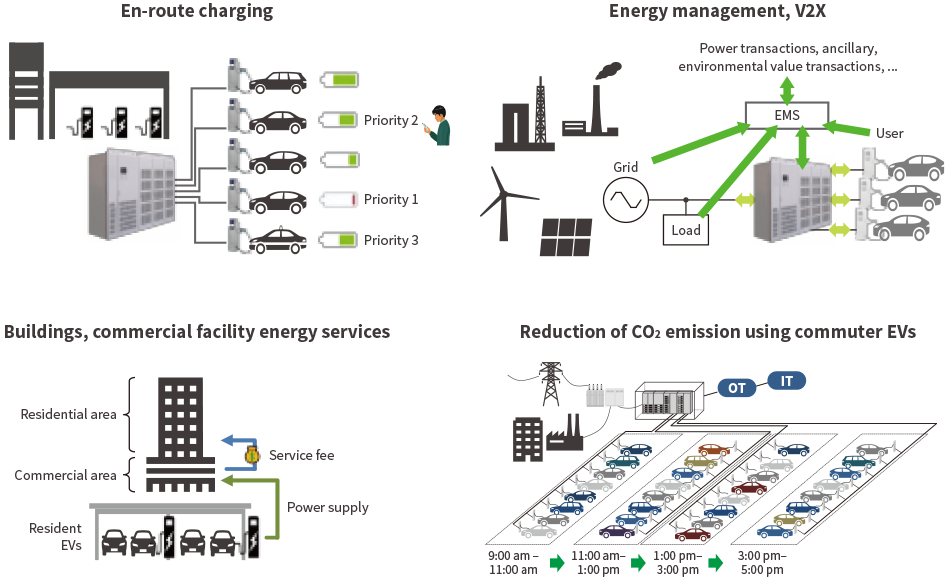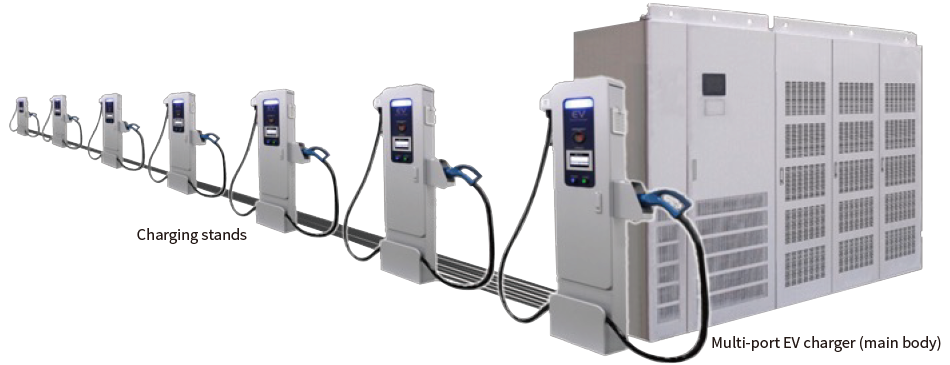Transition to Carbon Neutrality in the EV Value Chain (1)Multi-port EV Charger Contributes to Effective Energy Use Solutions in an EV Society
Highlight
Recently, public awareness of climate change and environmental issues has increased dramatically, and wide initiatives have been implemented to achieve carbon neutrality. In this situation, the role of EVs is becoming more important. There are several considerations and high hopes for EVs, not only EVs as equipment for transportation, but also infrastructure deployment for EVs, emergency power sources with EV batteries, and the recycling asset of used EV batteries. This series focuses on the "transition to carbon neutrality in the EV value chain," exploring new activities and future approaches involving Hitachi's wide range of technologies, products, and solutions. This article, Part 1 of the series, describes the multi-port EV charger being developed to be applied to solutions which will resolve issues in the mass-introduction of EVs and use EV batteries effectively. The multi-port EV charger features a multi-port configuration, large-capacity output, and a V2X function. This charger is expected to enable various use cases, including the gradual installation of facilities depending on the demand, flexible output capacity changes, highly efficient operations through a wide operation range, and energy management with charging and discharging management functions.
Hitachi is conducting multiple demonstrative operations now and steadily expanding functions necessary for several solutions. Hitachi will expand EV fast charging infrastructure collaboratively with various stakeholders.
1. Introduction
As a wide range of initiatives are being implemented to achieve carbon neutrality, the role of electric vehicles (EVs) is becoming increasingly important. This article describes the multi-port EV charger (fast charging equipment) and initiatives using this charger. Several parties both inside and outside the Hitachi Group have been studying new solutions for using the charging and discharging of EVs batteries to solve the societal challenges that accompany the increasing rates of EV deployment. However, an EV charger that can help implement these solutions does not yet exist in the market. In response, Hitachi Industrial Products, Ltd. developed and commercialized the multi-port EV charger, which can be applied to the solutions. Anticipating various use cases with multi-port EV chargers, some demonstrative operations are currently being carried out or prepared. The necessary functions will gradually be expanded.
2. Overview of Multi-port EV Charger
The multi-port EV charger is composed of the EV charger (main body), which contains one AC/DC converter, up to 20 isolated DC/DC converters, DC output switches, and other components, as well as up to 20 charging stands. In addition to the fast charging function, the charger can be combined with charging and discharging management functions for EVs (see Figure 1 and Figure 2). This section describes the functions of the multi-port EV charger and the highly efficient DC/DC conversion technology that is the core element of the charger.
Figure 2―Configuration of Multi-port EV Charger EV: electric vehicle, AC: alternating current, DC: direct current The EV charger contains an AC/DC converter, DC/DC converters, output switches, and charging stands. The charger can be combined with charging and discharging management functions for EV charging and discharging.
EV: electric vehicle, AC: alternating current, DC: direct current The EV charger contains an AC/DC converter, DC/DC converters, output switches, and charging stands. The charger can be combined with charging and discharging management functions for EV charging and discharging.
2.1 Features of Multi-port EV Charger
The three main features of the multi-port EV charger are a multi-port configuration, large-capacity output, and V2X (vehicle to X) function that supplies electric power from the EV battery to various devices.
In the multi-port configuration, up to 20 isolated DC/DC converters that can be operated individually are built into one EV charger. In the initial stage of EV deployment, not all of the DC/DC converters are installed, the equipment can be expanded in stages (units can be added) depending on the demand. The parallel configuration of DC/DC converters can also be changed according to the EVs to be charged, enabling the flexible adjustment of output capacity.
The need for chargers with large-capacity output is growing due to the increasing capacity of EV batteries and the demands of ultra-fast EV charging. The output current has been raised by increasing the number of parallel DC/DC converters, and the output voltage has been raised to cover a wider range of EVs, from the current DC450 V class to the DC850 V class that is expected to be widely used in the future. Through these measures, one multi-port EV charger can output up to 500 kW of DC power.
The V2X function can supply electric power from EVs' batteries to other devices via the EV charger. By using a bi-directional type of AC/DC converter and DC/DC converter, it is possible to discharge from EV batteries as well as charge EV batteries. When EVs discharge to the power grid, grid connection functions such as grid connection protections are required. To provide this functionality, Hitachi applied technology that has been cultivated for the grid-tied inverters used in renewable energy generation systems and electric power storage systems. By linking the V2X function with charging and discharging management functions, the multi-port EV charger can achieve the effective use of energy; for example, by shifting the peak of power demand, cutting demand peaks, and stabilizing the power grid against renewable energy generation. In addition to the simple functions built into the multi-port EV charger, advanced charging and discharging management functions that use various information can be implemented by connecting external charging and discharging management devices to the multi-port EV charger.
2.2 High Efficiency DC/DC Conversion Technologies
Figure 3―Conversion Efficiency of DC/DC Converters The DC/DC converter can perform bi-directional conversion of electric power, while at the same time, achieve high power conversion efficiency across a wide range of output voltages and output currents.
The DC/DC converter can perform bi-directional conversion of electric power, while at the same time, achieve high power conversion efficiency across a wide range of output voltages and output currents.
The increased adoption of EVs has resulted in a dramatic increase in energy consumption for EV charging. Therefore, it is important to improve the efficiency of EV fast charging infrastructure to reduce power loss. The DC/DC converter that is the core element of the multi-port EV charger is a dual active bridge conversion type using silicon carbide (SiC) devices and low-loss choke cores. This enables bi-directional power conversion and high conversion efficiency. Through Hitachi's proprietary soft switching control technology, a maximum efficiency of 98.8% and an average efficiency of 98.0% between DC200 and 800 V has been achieved, which is among the best in the industry. This enables high power conversion efficiency to be maintained across the wide range of output voltages and output currents (see Figure 3). The overall efficiency of the multi-port EV charger, including the AC/DC converter, is 95% or higher.
The wide output voltage range of DC150 to 900 V is also a key point. Although the DC450 V class is currently the mainstream of EVs, as DC850 V class EVs become more widespread, the DC450 V and DC850 V classes are expected to coexist in the market during the next five to ten years. It is a huge advantage for one EV charger to be able to support both voltage classes, rather than having to install different devices for each.
3. Initiatives Utilizing the Multi-port EV Charger
Figure 4―Examples of Systems and Solutions Utilizing the Multi-port EV Charger V2X: vehicle to X,EMS: energy management system,OT: operational technology,CO2: carbon dioxide A wide range of use cases are expected, such as en-route charging facilities, large-scale EV parking lots at offices, and destination or base charging facilities. Combining these with charging and discharging management functions according to the application can also optimize energy use.
V2X: vehicle to X,EMS: energy management system,OT: operational technology,CO2: carbon dioxide A wide range of use cases are expected, such as en-route charging facilities, large-scale EV parking lots at offices, and destination or base charging facilities. Combining these with charging and discharging management functions according to the application can also optimize energy use.
The multi-port EV charger is expected to be applied in several systems and solutions. It will enable the building of EV fast charging infrastructure at lower cost and in a more compact space. Examples include EV fast charging infrastructure for en-route charging on highways and in service areas, which has grown significantly in recent years, and large-scale EV parking lots at office buildings and other facilities that are expected to be deployed in the future. The capacity can also be expanded or changed flexibly according to EV charging needs. EV fast charging infrastructure for destination or base charging, like those at buildings, shopping malls, or offices, can be combined with charging and discharging management functions that use various types of information to optimize the overall energy use of the facility through the charging and discharging of EV batteries (see Figure 4).
The issues that must be addressed when deploying EVs and EV fast charging infrastructure vary according to field of business at the deployment location, and a variety of new solutions are expected to appear with the progress of social adoption of EVs. Companies in the Hitachi Group are studying the expansion of businesses that offer effective systems or solutions in each industrial field, and the multi-port EV charger is being commercialized as a product that can be applied as standard when constructing such systems. Since the number of EV charger operation methods and required functions will increase according to the issues faced or solutions needed when deploying EVs, Hitachi plans to systematically add more functions and configurations.
For wide deployment of multi-port EV chargers, it is also important to operate actual facilities and receive the associated feedback. Several demonstrative operations are currently being carried out and prepared. Utilizing large-capacity features, the demonstrative facility for the next-generation ultra-high output charging standard has been built at Hitachi Omika Works and is currently in operation. In addition, from the first half of FY2024, Hitachi Tsuchiura Works will start the operation of Workplace E-Powering (WEP), an initiative to reduce the CO2 emissions of commuter vehicles by installing EV fast charging infrastructure with the multi-port EV charger in commuter parking lots and adopting EVs as commuter vehicles. In the introduction of WEP, several issues and solutions are actually emerging. Hitachi plans to provide the accumulated know-how to customers who are considering introducing WEP. Preparations are also being made to demonstrate onsite energy management using the charging and discharging of EV batteries.
4. Conclusion
The multi-port EV charger is expected to contribute significantly to the EV society. The improvements enabled by this charger include expanding EV fast charging infrastructure while curbing facility investments, providing a wide range of fast charging opportunities according to needs, reducing power consumption through higher efficiency, and using energy effectively through charging and discharging management. Hitachi will expand the application of this product sequentially in various industries where the adoption of EVs will continue in the future, such as medium- to large-scale base or destination charging at offices, buildings, public facilities, transportation companies, and logistics vendors. Hitachi will cooperate with all stakeholders, such as EV charging standards-setting bodies, government ministries, power transmission and distribution system operators, EV charging service providers, and EV manufacturers. Together they will make every effort to boost the expansion of EVs and EV fast charging infrastructure.
REFERENCES
- 1)
- Hitachi Industrial Products, Ltd., “EV Charger”
- 2)
- Hitachi Industrial Products, Ltd. News Release, “Participation in the CHAdeMO3.0 (ChaoJi2) Demonstration Project for the Next-generation High Power EV Charging Standard” (Oct. 6, 2022)
- 3)
- Hitachi Industrial Products, Ltd. News Release, “Hitachi Industrial Products to Launch High-capacity Multi-port EV Charger that Contributes to the Expansion of Charging Infrastructure and Growth of EVs towards the Realization of a Decarbonized Society” (Sept. 19, 2023)
- 4)
- News Release from Hitachi Industrial Products, Ltd., “High-efficiency Multi-port EV Charger that Contributes to the Expansion of Charging Infrastructure Received a Judge Committee's special award at the 53rd Japan Industrial Technology Awards organized by Nikkan Kogyo Shimbun” (Apr. 4, 2024) in Japanese.




